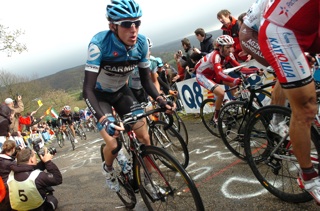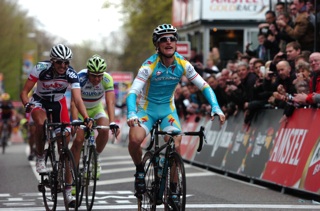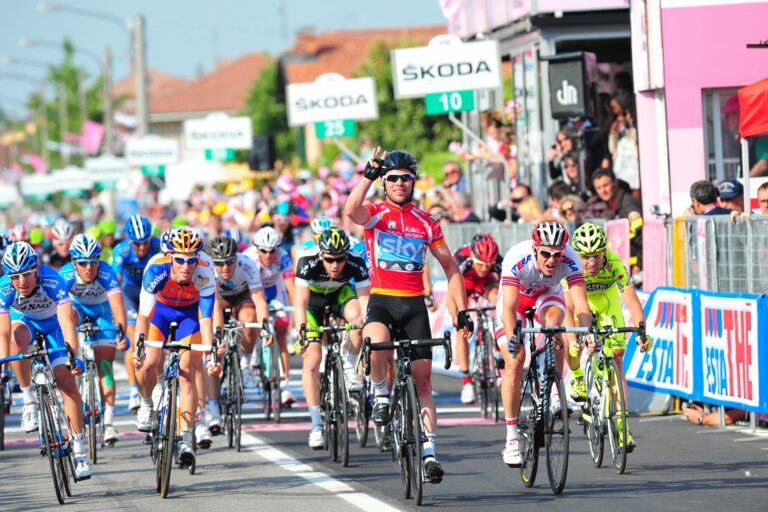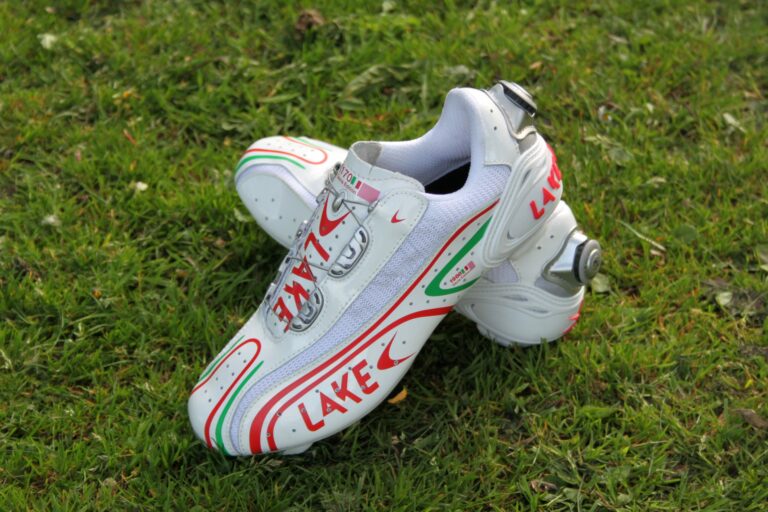Yesterday’s Liege-Bastogne-Liege offered an extended view of the climbing technique of the world’s best cyclists.

The parcours for the 98th edition of La Doyenne, included some 11 climbs in 257.5km, among them the one kilometre, 11 per cent Côte de Saint-Roch, the 12.2 per cent Côte de Stockeu, another climb of just one kilometre, and the brutal closing trio of the Côte de La Redoute, the Côte de La Roche aux Faucons, and the Côte de Saint-Nicolas.
A mix of Grand Tour climbers and Classics hardmen contested the finale, with Maxime Iglinksy (Astana) and Philippe Gilbert (BMC Racing) flying the flag for the one-day specialists and Vincenzo Nibali (Liquigas-Cannondale) and Dan Martin (Garmin-Barracuda) among those who have conquered the climbs of cycling’s biggest stage races.
Like Belgium, the UK has an abundance of short, sharp steep climbs. So how can you get them up faster? What skills and training are needed to dish out some Nibali-esque acceleration to the Sunday morning chain gang when the road goes suddenly skywards?
We asked British Cycling coach, Dan Bennett of Progressive Cycle Coaching, Tom Kirk of Custom Cycle Coaching, who manages elite-level cycling teams in the UK and abroad, and Marc Laithwaite, a level three coach with the Association of British Cycle Coaches, for their tips on becoming a more effective ‘power climber’.
Take a seat or remain standing?
Much debate surrounds the relative efficiency of climbing in a seated position at a low cadence, and pedaling out of the saddle to turn a bigger gear. Lance Armstrong was famous for spinning a low gear on the endless climbs of the Tour De France, but how efficient is that for the short, painful bergs of the Ardennes Classics?
“Although your climbing speed may not be quite as quick, on climbs of less than 10 per cent it is more efficient to climb in the saddle using a high cadence rather than to stand and push a higher gear, as your precious muscle strength will not be taxed quite so much,” says Bennett. “This allows you to ride the final climbs of the Ardennes Classics with more power.
“If you have a climb that is very short, a quick punchy effort out of the saddle will get you over the climb without a loss in speed. The knack is to know which to use and to ensure you have the right gears on the bike.”
For Kirk, the suitability of either technique rests with the build of the rider and with the gradient of the climb.
“The physiology of certain riders allows them to sit and spin but many rely on the extra power created from riding out of the saddle in a higher gear on the short steep climbs that make up the Ardennes Classics and also many of the climbs we encounter in the UK.
“The length and gradient of these climbs mean that often a ‘rouleur’ with higher absolute power has an advantage over a pure mountain climber that would excel in the high mountains.”
Laithwaite identifies a lack of ‘force production’ – the ability to produce high power for a short period of time – from lab tests, which he ascribes to the increasing popularity of triple and compact chainsets, encouraging riders to pedal at too high a cadence. “As a consequence they have little leg strength,” he says. “Many people are forced to change into easier gear as soon as they reach any short, steep hills, thereby losing all speed and momentum. In shorter, hilly time trial events, having enough leg strength to attack shorter hills and maintain speed is very important,” he says.
Lighten up or put the power down?
The physiological differences highlighted by Kirk are readily apparent to observers of the Ardennes Classics. Philippe Gilbert, for example, winner of all three Ardennes races in 2011, and a contender for each this year, boasts a powerful build that prevents him from contesting the Pyrenean or Alpine climbs on which a rider like 2009 Liege winner, Andy Schleck, excels. Is the most effective way to become faster on ‘Classics’-style climbs simply to shed a few pounds or is this an over simplification?

“True natural climbers in the Pantani mould are able to explode out of the saddle to attack using their huge power to weight ratio but on the longer climbs spinning a lower gear in the saddle will be more efficient,” says Kirk. “The extra energy cost of using the upper body will mean that you fatigue faster compared to using the powerful leg and gluteus maximus muscles. Of course, when the gradient steepens and the attacks start, most riders need to get out the saddle and push to keep up.”
For Bennett, lighter is almost always better when it comes to going uphill. “In general the lighter you are the better you’re going to climb,” he says. “More specifically a good efficient climber has a higher power output with a lighter body. So if you have some extra layers of insulation around your torso losing some of it whilst maintaining or increasing your power will make you climb faster.”
Laithwaite concours. “Lighter riders are more efficient whether in or out of the saddle, power to weight ratio is absolutely critical for successful climbing. Riders we test are often able to produce a high amount of power but their heavy weight places them at a real disadvantage when riding hilly courses.
A mountain to climb?
Practice makes perfect is a time honoured mantra, but cycle training has become increasingly sophisticated and an emphasis on miles and more miles is increasingly replaced by specific training. Is regular hill riding essential to becoming a better climber or can riders in east Anglia develop similar abilities to those living in hillier regions?
Laithwaite argues that while it helps to train on hills, riders who follow programmes that make them lighter and able to produce more power than their rivals will always go uphill faster. “During groups rides, some people will always be better climbers than others, irrelevant of whether they train on hills or not. They are generally the ones who have the best combination of fitness and weight,” he says.
Bennett believes that while training on hills is a bonus, it isn’t essential to becoming a better climber. “Those of us living in flatter parts of the country can prepare on the turbo (raising the front wheel a few inches to mimic the climbing position) or out on the road riding into the wind,” he says, “but if you do have hills around you it is best to use them it is the best option.”
Kirk concurs. “Unfortunately, the terrain in the UK makes it harder for UK riders training for the type of climbs we encounter in events such as l’Etape du Tour and La Marmotte to train with specificity,” he says.
“I recommend manipulating your gearing and cadence to allow long, high paced efforts in a bigger gear and lower cadence than you would normally ride on the flats to simulate the efforts you will encounter. If you can’t find the shorter, steeper climbs nearby, focussed work on the turbo and lower-body weight training over the winter can improve your strength to allow you to sprint over the climbs at a higher power.
Waiting to explode
Perhaps the key difference between riders who do well on the short, steep climbs of the Ardennes Classics, riders like Freire and Gilbert, and the ‘angels of the mountains’ who soar into the distance on the endless inclines of the Grand Tours is the ability to deliver a sudden, explosive burst of power. Enrico Gasparotto’s assault on the Cauberg to win this year’s Amstel Gold Race is a recent example. How can such explosive power be developed?
For Kirk, the tried and trusted method of hill reps pays dividends in efforts to emulate the hardmen of the WorldTour peloton who relish Ardennes

Week. “Explosive climbing relies on strength and power and hill reps on a short, steep climbs from a slow start are great for this,” he says.
“Try riding up a short steep hill at maximum effort from a standing or slow rolling start for great on-bike strength training. An important thing to remember for racing is that attacks will often go over the top of a climb where most riders ease up as they crest the hill.
“Training yourself to keep going and sprint over the false flat can really help in key moments of a race so add in some longer climbs where you ride the majority of the climb at 80 to 90 per cent effort then attack over the last 100 metres.”
Bennett suggests finding a local hill about two minutes long. “do repeats up that hill taking around five to 10 minutes in between each effort.”
He adds: “Another way is when you’re out on a ride power up each short climb you come across really working yourself up the climb as fast and a quickly as you can.”
Laithwaite suggests ‘stomps’: a straight-forward drill that can be completed on a quiet road as part of a regular training ride.
1. Change into big gear
2. Slow the bike to a crawl
3. Sit absolutely still on the bike with no movement from the pelvis upwards
4. Stamp on the pedals as hard as possible, 10 pedal strokes in total
“You should find it really hard to get the bike moving and its likely that you will not have built up a great deal of speed by the time you’ve completed 10 pedal strokes,” he says, “but that’s fine.”
‘Stomps’ should be completed in sets of five, with rests of one minute between each. One to two sets should be completed in an hour, separated by 30 or 60 minutes.





